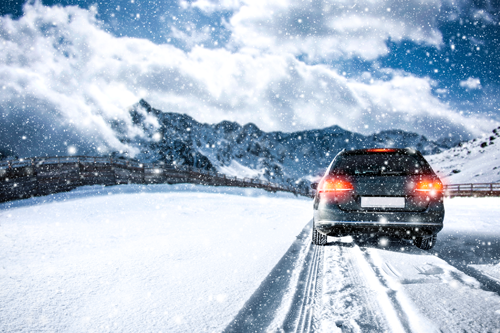Anyone who’s weathered a Colorado winter knows something about our somewhat unpredictable climate, from abrupt heat waves to jarring temperature drops, sudden gales and blizzards, ice storms followed by flashmelts — and sometimes all of the above in one day. Like all winter sports, driving in the Centennial State’s colder months takes preparation, savvy, and patience. Here are some useful driving tips for getting safely through the storms ahead.
1. Know your vehicle — and its limitations.
With the advent of antilock brakes and traction control, many of the old rules about winter driving, such as pumping your brakes in a skid, no longer apply. But drivers still need to know what kind of technology they’re equipped with, and what it can and can’t do. In the depths of winter, many mountain roads shouldn’t be attempted without all-wheel drive, high clearance, and/or tire chains; and, contrary to some drivers’ beliefs, even all-wheel drive can be useless if you happen to be on a friction-free stretch of ice.
2. Bring the right tools.
At the very least, you should have an ice scraper and snow brush, proper winter clothing, and cell phone (no texting, please) along for the ride. For long-range trips, blankets, food and water, an emergency kit, any needed medications, and a snow shovel should be on board, too, and keep plenty of gas in the tank to help keep the fuel line from freezing.
3. Brush up on visibility.
Slippery roads aren’t the only problem. A major hazard in many winter driving situations is limited visibility, thanks to blowing snow and the icing of windshields and wiper blades (which should be replaced every year). Incredibly, drivers often compound the problem by not bothering to clear their windows (particularly their back windows) before hitting the road, figuring the defroster will eventually take care of it. Taking a few extra minutes to scrape and defrost before setting out greatly increases your prospects of being able to see what’s going on around you and avoid a crash.
4. Don’t be a statistic.
Cars that offer keyless ignitions and remote starting features have compounded a common problem — people leaving cars to “warm up” in closed garages, which can lead to potentially fatal levels of carbon monoxide overpowering drivers or other family members. Never leave your car idling in a closed garage — or, for that matter, idling unattended in your driveway, which could be in violation of local “puffer” laws and encourage car thieves.
5. For serious winter driving, get serious winter tires.
All-season tires are intended to competently handle a variety of middling road conditions. But “all-season” doesn’t mean “all-winter.” If you expect to be routinely facing extreme winter conditions, such as heavily snow-packed roads, you should talk to your tire store about tires that are specifically designed to offer superior traction in snow and ice. That means having to switch tires in the summer in order to extend the life of your winter grippers, but if you are facing months of serious snowfall and frosty nights, it could be worth it.
6. Easy does it.
In icy winter conditions, accelerating, braking, and maneuvering through traffic should all be done at a gentler pace, with frugal use of the gas pedal and the brake. Don’t gun it from a stoplight, unless you like spinning your wheels futilely. AAA recommendsthat “the normal dry pavement following distance of three to four seconds should be increased to eight to ten seconds,” to give you more time and distance to brake if needed. Going slower takes longer, but it greatly increases your chance of actually getting somewhere.
7. Use your momentum.
It’s best to avoid flooring it to get up a hill or jamming on the brake going downhill; if you let the car’s own weight help to regulate your speed going up and slow you coming down, there’s less chance of a skid. It’s also important to turn off the cruise control in wet or snowy conditions, since it can cause surges of acceleration at inconvenient times and lead to hydroplaning or worse.
8. Avoid unnecessary trips.
If the weather alerts are screaming about an impending blizzard, ask yourself one question: Is this trip really necessary? Sometimes the safest option in extreme weather conditions is to put another log on the fire and wait for the plows to make things a bit more bearable.
THE CAR CRASH LAWYERS AT FDAZAR
For more than thirty years the attorneys at Frank Azar Car & Truck Accident Lawyers have helped thousands of injured people obtain complete and timely compensation for their losses. Our proven track record and expertise have allowed us to grow into the largest personal-injury law firm in Colorado, with offices in Denver, Aurora, Fort Collins, Thornton, Grand Junction, Greeley, Colorado Springs, and Pueblo. If you’ve been injured in a bus, car, truck, bicycle or motorcycle accident, you may be entitled to compensation. Please call the car accident attorneys at FDAzar day or night at 800-716-9032, or contact us here for a free consultation and no-obligation evaluation of your case.




